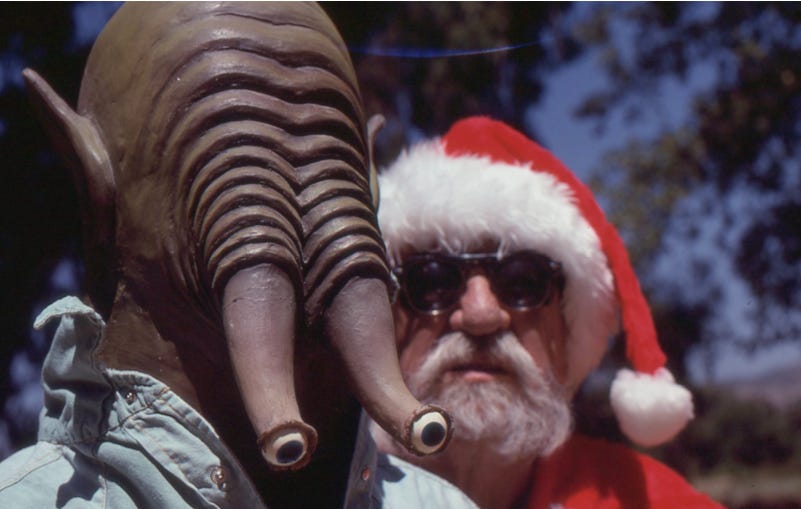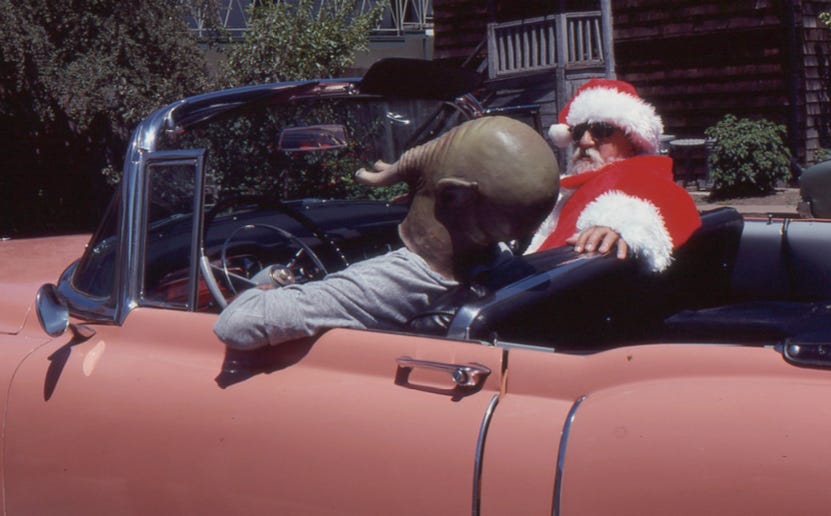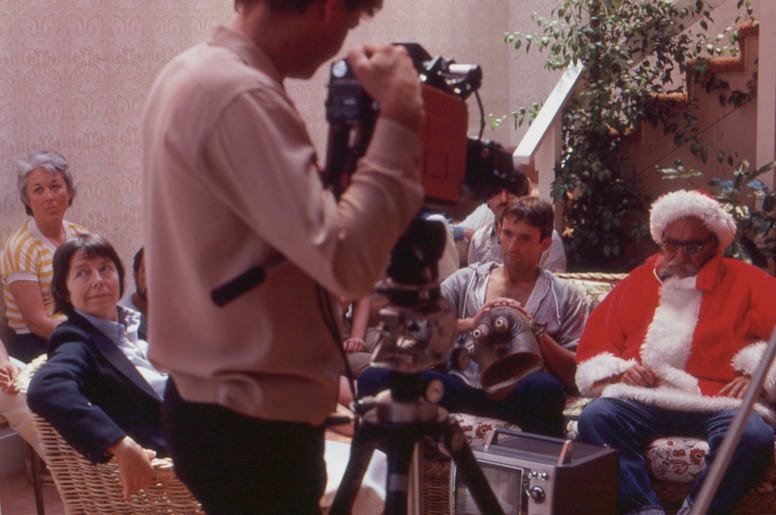FINAL SHOTS––Letting EMERALD CITIES Tell Me What’s Missing. And fate delivers me my third "trilogy" actor, Dick Richardson, upon who's head Billy Hiebert's rubber MARTIAN MASK fits nicely!
https://bynwr.com/videos/emerald-cities
Experpted feom my book, NEW DARK AGES––HOW A PUNK MOVIE EMERALD CITIES GOT ITS IMPROV
————.
FINAL SHOTS
Letting Emerald Cities Tell Me What’s Missing.
When there is no obvious budget, it is always a strain to realize that you have to invent more production funds once again. Mostly, it helped to have friends, for whom money was incidental, to contribute to my work. Again, soundman/friend Nick Bertoni joined me for on-location recording (Sure, Rick, Where?). And Bill Kimberlin, with his Eclair NPR camera, again offered his assistance. Actor Ed Nylund was again central to my performer needs, as was punk rocker/Flipper guitarist Ted Falconi. The lead, Carolyn Zaremba, had moved to New York City during the elapsed time I’d been producing/cutting, so she seemed temporarily out of the picture. She was charting her own life in the theatre scene there, so I was happy for her.
And the timing of actor/friend, Dick Richardson getting out of Lompoc Federal Penitentiary where he’d been serving time on a drug charge, had also spurred me on to shoot additional footage. I was happy to pick Dick up at the Greyhound bus station and prepare him for his role in the final work. Before any film talk began, though, I asked him the million dollar question, “How did you avoid getting hurt...killed in prison?” I had wondered about this––probably most readers would too, who have not been incarcerated. As we rolled along, up San Pablo Avenue in Oakland, Dick explained how he had survived.
“You have to l o o k a certain way,” Dick explained. “You have to either be an animal, or an actor. One of the two. And you’ll get by.” I may have even asked him to show me the kind of face he had to make to pull that off. I later scripted Ed asking the same question I had posed, so Dick could elaborate on his surviving prison/not getting stabbed story. In this manner, I would add a bit more angst to Ed’s hitchhiking adventures.
In any case, viewers of Emerald Cities will recognize this material. This is the meat of the scene I would shoot between him and Ed, when they’re parked on the bluff above Point Richmond, California, looking out over the San Francisco Bay and The City beyond. And because I was still in touch with artist friend Lowell Darling, it made sense to ask him to join in the upcoming scene as well. Lowell, with girlfriend/artist Katherine Sherwood, would be positioned in a car already parked on the bluff, as Ed and Dick arrived.
During this time that I was assembling people and the tech stuff for this hopefully final shoot, I spotted a gorgeous vintage, ‘pink-ish’-colored Cadillac, parked along the road in Berkeley, and found myself begging the owner to let me use it in the movie. He turned out to be the artist Brian Wall who worked with ceramic sculptor Peter Voulkos and was well known in his own right. Surprisingly, he granted me the loan of that terrific vintage prop. When you watch EC, you’ll realize what a huge leap of faith it took by Brian, to let that beautiful––and expensive––car out of his sight.
Before the scheduled shoot-day arrived, with my filmmaking antenna still on high alert, a visit to friend sculptor Billy Hiebert’s studio, as just a friendly break from moviemaking, landed me and the movie another very special prop for what I’d planned. I’d gotten to know Billy after he taught one of my early classes at CCAC. While I hung around his machine shop that day, he showed me an amazing rubber mask he’d just created, a “Martian” head with long droopy eye pods, strange green ledges across the face, and wrinkled skin. It was like nothing I had ever seen. I must have begged him pretty intensely to grant its usage in my upcoming movie shoot, because he handed it over before I left the premises It didn’t take long to add two and two, see the mask as a device for the ex-con Dick character.
Over time, leading right down to the day of shooting, I had mentally assembled a very strange laundry list for upcoming scenes. Here’s something of what was included:
1. Scene of Ed/Santa hitchhiking, with Dick picking him up in Cadillac. Ed asks Dick how he survived in prison, as Lowell Darling and girlfriend look on from next car.
Dick Richardson wears Billy Hiebert's Martian mask, and Ed Nylund is Santa. ©1983. L.L. Productions
2. Ed wanders around in San Francisco, somewhere outside (train yards?), and also inside somewhere. If Nick can get us permission to shoot in the S.F. Exploratorium, where he works, that would be great.
3. Ed-as-Santa “Death Scene,” using fake-but real looking wooden pistol from Chan Is Missing that I still had from Wayne Wang’s movie. We’ll shoot scene somewhere in downtown San Francisco.
4. Curbside interviews with San Franciscans, about whether or not they like Santa. An interviewer will ask random people, Have you heard Santa’s been killed? Shot dead? I now fully embraced the logic of using that concept. The most obvious choice to handle the interviews was longtime friend, video artist and actor in Showboat 1988 and my first 16mm film, What Flirting Cost me, Willie Boy Walker, who had been doing similar in- person videos with videographer Dana Atchley for several years, following his stint with TVTV in LA, working with John Belushi, Bill Murray, and several other future SNL comics.
5. Ted Falconi driving through downtown San Francisco with runaway daughter Z riding shotgun––will not show her...she’s in NY, but I will just feature her hot-pink dress from the desert, blowing in the wind inside car, to give her character some presence.
6. Transfer to magtrack the recordings of my life- stories from childhood about Christmas and other things, like getting a forced haircut, age ten or eleven, and mirroring my father’s limp at age three or four.
Plus, I will need to shoot old photos from the 1950s of me and family, and whatever else may fit into green montages that I’m using as TV programming.
Sculptor Brian Wall’s loan of his Cadillac convertible greatly added to the bizarre sequences with Martian & Santa. Photo by Julie Schachter.
7. For the biggest stretch of my strange conceptual meanderings, I imagined Dick and Ed traveling, via Cadillac, to a past-life hypnotism session in Berkeley. Freda Morris, who I had become aware of somehow, had surprisingly agreed to play a role in my movie, to appear with her weekly class, hypnotizing my characters in costume. Joe Rees agreed to supply TV monitor, video deck, and shoot video, while Bill Kimberlin and I would shoot 16mm.
8. Martian mask scene—Dick wears it at Freda’s hypnosis session and then somewhere else (on street in SF?).
By the time of the shoot, Dick was living in a halfway house for ex-cons in San Francisco, oil painting in his small room. So that became another location shoot for him in the mask. My costumed epic now included guitarist Ted Falconi donning his torn, black Flipper coat, Ed in red and white Santa garb, Z wearing her 1950s pink chiffon, and Dick with a green Martian helmet.
WRAPPING UP THE SHOOT(S) Martian Mask & All
Once again, friend and fellow fimmaker Bill Kimberlin saved the day with his rental and co-camera help, while Nick Bertoni again graced my movie with his on- location sound recording (as he would later do for my 1987 feature Morgan’s Cake). Each of the concepts of this last group of scenes had its own added risks and excitement built in. Shooting at Freda Morris’s past- life hypnotism class with its small group of students was certainly a stretch.
After Joe Rees met us there, I settled Ed and Dick on the sofa. Freda played it perfectly for the cameras (both video and 16mm were shooting), by simply handling the two characters as if they were business as usual. Dick was definitely uncomfortable in the Martian mask, so we opened by getting him to remove it at her professional urging. He looked beautifully disoriented then, and actually did maintain that off-kilter vibe throughout all his scenes.
When it came time for Freda to try and get Dick into a hypnotic trance, explaining that he would relive the death experience, he became a little freaked out. “I don’t want to be burned at the stake.” Of course, his reaction was not planned or anticipated (strictly improv). Freda said she’d stop if that happened. Ed also made it clear that he didn’t want to be incinerated either, so that set the stage for whatever came next.
As Ed closed his eyes (I’m sure he’d been drinking his usual hard liquor, but I had no idea how much), Freda went to work on Dick. In the final movie you can watch as Dick, eyes closed, grimaces–– he seems to be going through some serious pain. I heard later that he’d experienced his death by swords. He remembered looking out tiny panes of glass in a very old Russian dacha, watching Cossacks attacking.
Freda Morris (left) prepares to hypnotize Dick Richardson, as her small class looks on. (Joe Rees/TARGET VIDEO on camera), Photo by Julie Schachter
Eventually, the whole past-life concept even dragged me in front of the camera, wearing Z’s pink dress. After I experienced being hypnotized by Freda Morris––yes, I was also put in a past-life trance––I experienced being in other real-life roles. What lives did I lead in the past, you ask? I remembered two. In one I was a red- haired, lanky thirty-something man, wearing little more than a loin cloth, and I was digging up some pottery object at the bottom of a rather deep hole. My second life was that of an old man with tiny spectacles, with a watch repair business that was housed in a small ground-level shop. So I could see only people’s feet go by outside the window. (I remember feeling that I looked something like President Harry Truman.) Freda had commented, as I was speaking in trance, that maybe with my watch-making I liked to look at people through my polished lenses. And that, she thought, was perhaps the basis for my filmmaking interests in present day. (In Emerald Cities you can see me on-screen with eyes closed, white visor hat, while I’m narrating my real-life stories intercut with family pictures.
As editing the past-life footage progressed, I suddenly paid special attention to Freuda’s countdown of 1-to-10, spoken as she talked Dick into a deeper and deeper trance. I suddenly realized I could possibly use it as the soundtrack to an earlier shot I’d taken of Dick-in-mask, strolling down a San Francisco street. With me gripping Bill from the back, so he wouldn’t trip with his precious Eclair NPR camera while walking backwards, we had filmed Dick in the mask, strolling half a block adjacent to a wall with lines of cracks that almost exactly matched the weird ripples in the Martian mask. That traveling shot, filmed at a slow pace, was inexplicably in tune with Freda’s countdown. Her commands, “Look around you,” and, “Look down your feet” are right in sync with Dick’s movements. I’m still amazed at the coincidence when I watch the movie. It was just another location/editing miracle, joining the Improv List of what it took to make this movie.
————
The Old New Dark Ages, by Keith Phipps
“Sometimes an idea for a feature film comes to you in one line, or in a single flash of inspiration,” Rick Schmidt writes in his 1988 book Feature Filmmaking at Used-Car Prices. “My film Emerald Cities began with the single thought: What would it be like to watch the events of the modern world in 1984 on TV from a shack in the middle of the desert?
—————







Two thoughts reading this morning’s post:
1. I had no idea you’d actually experienced a past life regression! Would love to hear/read more about this sometime. (I’ve become a true believer in reincarnation since encountering so many stories of Near Death Experiences, Pre-Birth memories, etc. over the last few years when I’ve been obsessed with Spiritually Transformative Experience (STE) accounts, many of which include past life encounters.)
2. One thing that stood out in this post is the willingness to DO THE HARD WORK. You can be inspired, believe it’s possible, feel the Love, etc., etc. - all that good stuff - but if you aren’t willing to simply make the effort to keep it going . . . it ain’t going. I’ve struggled with giving up on things because there’s too much effort required, and it’s inspiring to read about the fruit of your hard labors.